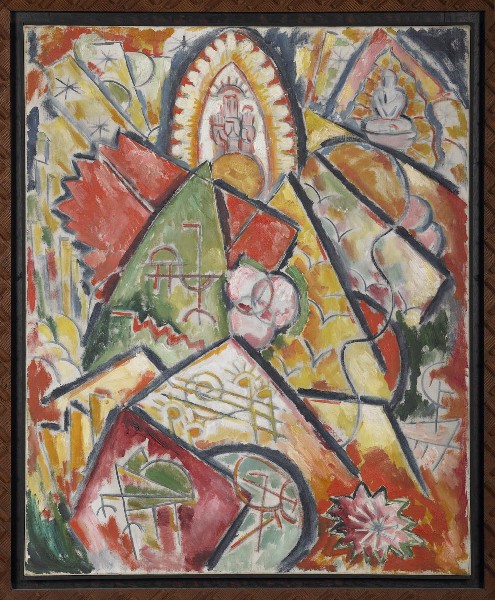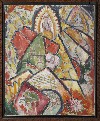Framing the Rose
De Gustibus
By: Charles Giuliano - Nov 06, 2014
During a recent review of Marsden Hartley: The German Paintings 1913 to 1915 at the LA County Museum of Art I remarked on the removal of a hand carved frame for “Musical Theme Oriental Symphony” (1913) in the collection of the Rose Art Museum.
The painting was readily familiar from my undergraduate years at Brandeis University Class of 1963.
There was a disturbing aspect to seeing it again.
As I reported “When not installing shows, under former director Carl Belz, the artist/ preparator Roger Kizik created unique frames for special works. His carving for the Hartley wonderfully echoed the patterns in the painting. His treatment so richly enhanced the experience and understanding of the work. It was so sad in LA to encounter the painting stripped of that loving tribute. Now it looks stark and plain in a generic frame.”
It seems that this touched on a raw nerve.
In the past ornate frames were used to enhance paintings. The prevailing current taste is not to “compete” with the pure pleasure of viewing the work. Elaborately carved and gilded frames remain appropriate for Old Masters but there are different approaches to modernism and contemporary art.
Just where do you draw the line?
With the encouragement of then Rose director Belz the artist/ preparator Kizik was encouraged in his ambition to make unique frames for special works in the collection. This was done with great skill and sensitivity.
The frame for the Hartley was particularly successful as a dialogue between a contemporary artist and an iconic work by one of the great masters of American Modernism. Viewing the painting with this treatment was particularly rich and evocative.
Seeing it on view with a generic, unobtrusive surrounding made me feel as though the work had been circumcised. It infuriated me.
What follows is a response from Kizik.
Very pleased to see your well wrought and perceptive review of this Hartley show, and cannot thank you enough for remarking upon Musical Theme's MIA frame - of which Barbara Haskell (curator for the Whitney Museum’s Hartley exhibition) herself welcomed seeing in show that you cite.
A few years later, when she happened to be at the Rose while her husband, Leon Botstein, was interviewing as a candidate for the Brandeis presidency, she re-visited the picture, with Carl in the Rose storage room. She still responded warmly to it, and commented again on the frame - Carl then asked if she'd like to meet its maker - I was in the shop a few steps away and was delighted to meet her, as that show was always one of my favorite exhibits.
Deb Wye, from MoMA, also saw the Whitney show, and raved about the frame to me [she and Paul Brown are long time friends]. Of course, we lent the picture to a number of shows over the years, and favorable comments about it would find their way back to us in a review, or a curator's note.
As you mentioned, I made a number of frames for work at the Rose, sometimes on my own initiative, but often at the suggestion of Carl or Susan Stoops. (later curator for the Worcester Art Museum). This continued under (director) Joe Ketner, but by that time I was more involved in overseeing construction of the Foster Gallery.
The criterion was always to enhance the presentation of the work, and evoke the spirit of each particular artist. Other examples were a Braque still life sporting a heavily 'roped motif' frame, and a 1929 Leger [shown last spring at Rose] with a linear arabesque surround, carved in relief.
These, and others, were inexplicably 'purged' and returned to me during the tenure of Michael Rush and the turmoil following his departure. Since I did not have great rapport with Rush, questioning his decision seemed awkward at best - seeing those paintings [all have been re-framed in a tasteful but generic manner] now is deeply dismaying, since their magnitude, in my opinion, is much diminished. Your own unsolicited comments [at least regarding the Hartley] seem to confirm that.
Fortunately, some of my frame work remains in place - Max Beckman, John Graham, Picasso, Bonnard, Rauschenberg and others - but I would love to find a way to re-open the discussion with the current Rose team [I remain good friends with Roy Dawes and am convinced he had no part in this].
While I am thrilled to see the museum so strongly resurrected under Chris Bedford, I don't have any particular connection to him - we talked briefly at his official reception, but it's never gone further. Since you likely have more of Chris's ear than I, perhaps your sharing with him what you touched upon, and how it affected your perception of 'Musical Theme', may resonate with him - I am certain he is unaware of its previous 'countenance'.
Though I consider myself, first, an artist, I always valued my years at the Rose, and the collegial atmosphere in evidence under both Carl and Joe. While the installations we did came and went, I think [naively?] of the frames from my shop as something of a legacy that enriched the collection, and had hoped they would remain so.


